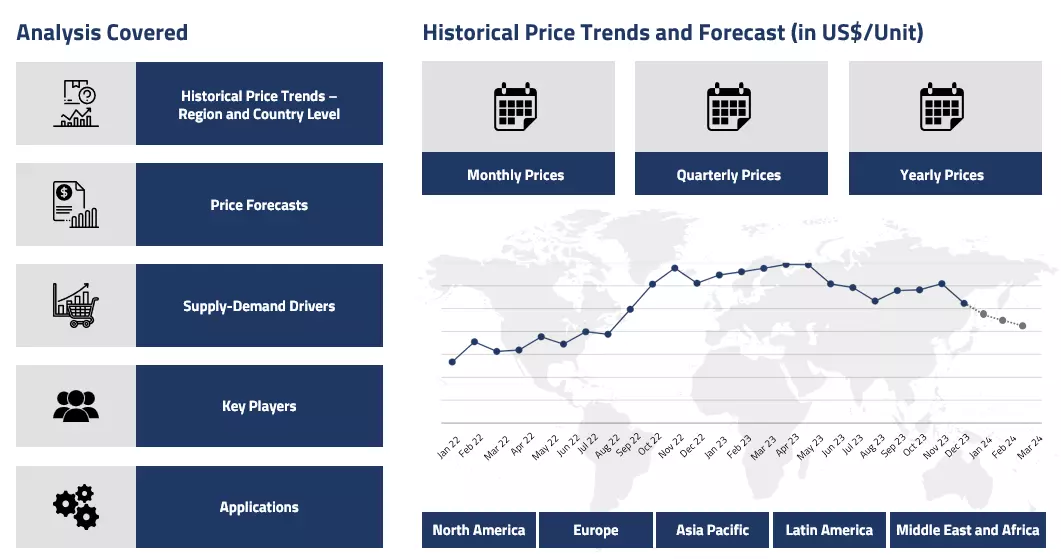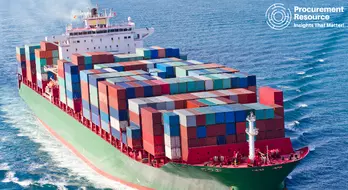Product
Diesel Price Trend and Forecast
Diesel Price Trend and Forecast
Diesel Regional Price Overview
Get comprehensive insights into the Diesel market, with a focused analysis of the Diesel price trend across Asia, Europe, North America, Latin America, and the Middle East & Africa.
Diesel Price Trend for the Q3 of 2024
| Product | Category | Region | Price | Time Period |
| Diesel | Operating Costs, Logistics and Utilities | China | USD 956.12 /MT | September 2024 |
Stay updated with the latest Diesel prices, historical data, and tailored regional analysis
Asia
In Asia, particularly in China, the diesel market grappled with persistent demand challenges. A notable shift towards alternative fuel sources, particularly liquefied natural gas (LNG), has altered the landscape for diesel consumption. The Chinese economy faced headwinds from a slowdown in key sectors, which has historically driven diesel demand for logistics and transportation. This decline has prompted a significant reevaluation of diesel consumption patterns.
Diesel Price Chart

Please Login or Subscribe to Access the Diesel Price Chart Data
The introduction of LNG-powered vehicles has further displaced diesel demand, as evidenced by rising sales figures for LNG trucks. Consequently, Chinese refineries have responded to the decreased demand by adjusting output levels. The overall sentiment in the Asian diesel market indicated a cautious outlook, with prices under pressure as market participants sought to navigate the implications of changing fuel consumption trends and economic uncertainties.
Europe
In Europe, diesel prices experienced a complex interplay of factors that contributed to fluctuating price movements. The region saw an increase in petroleum product exports, providing some support to diesel pricing. However, the market was also characterized by regional oversupply, driven by high refinery outputs that often exceeded local demand. European refineries maintained robust production levels, which exerted downward pressure on prices.
Additionally, maintenance activities at select refineries influenced local supply dynamics, with some areas experiencing temporary reductions in availability. The net effect of these competing influences created a mixed price environment across European countries. While some markets saw brief upticks in prices due to supply adjustments, the overarching trend indicated a cautious stabilization as industry players monitored global oil market fluctuations and regional consumption patterns.
North America
In North America, the diesel market displayed a trend of relative stability, albeit with underlying volatility influenced by crude oil price fluctuations. The U.S. market saw a consistent decline in diesel prices, supported by returning refinery premiums to pre-pandemic levels. As summer transitioned to fall, the market faced shifts in demand associated with seasonal patterns.
Lower crude oil prices played a pivotal role in shaping diesel pricing dynamics, allowing for a degree of price moderation in many areas. However, regional disparities remained pronounced, with some states experiencing higher prices due to localized market conditions. This regional variance was further compounded by refinery operations and maintenance schedules, affecting supply availability in certain markets. The North American outlook remained cautious as industry stakeholders kept a close eye on crude oil trends and refining capacity, which would ultimately determine the direction of diesel prices in the coming months.
Analyst Insight
According to Procurement Resource, the price trend of Diesel is expected to remain of the lower end of the pricing spectrum as the constant fluctuations regarding the demand and supply in the energy sector might not translate well in the next quarter for diesel.
Diesel Price Trend for Q2 of 2024
Asia
The price trend of diesel in Asian countries was shaped primarily by the changing reforms and crude oil market. In Malaysia, after remaining almost stagnant in the early phase of the second quarter, diesel prices inclined by a noticeable margin towards the end. This surge was the direct consequence of the restructuring of the government’s fuel subsidiary system. This was initiated in response to combat fuel smuggling issues and reduce the fiscal burden on the economic sector.
In China, on the other hand, the prices of diesel remained on the lower end of the pricing spectrum. The market initially struggled with the weak cost support from the crude oil sector and reduction in risk premiums as the tensions in the Middle East started to ease out.
Although it was expected that the May Day holiday season might spur the demand for the commodity, the market moved in the totally opposite direction. Therefore, under these situations, the production units lowered their load in order to prevent overstocking, which bore fruitful results towards the end of the quarter. The Dragon Boat Festival also brought some positive changes in the demand for the commodity, suggesting some improvements in the pricing quotations in adjacent quarters.
Europe
The European diesel market is one the biggest consumers of diesel in the world and relies majorly on imports from the US, APAC, and Middle East. With the advent of the second quarter of 2024, the traders of the commodity witnessed a slow demand and rising flows into the region, particularly from Asia Pacific and the US.
The sluggish behavior of the market was further influenced by the additions in global refining capacities, adding onto a substantial number of stockpiles and suppressing the overall momentum of the market. However, as the end phase of the quarter approached, the demand for diesel picked up, supported by increased transportation activities, raising the trader’s expectation for the second half of the year.
North America
In the second quarter of 2024, U.S. diesel prices were pressurized by weak demand, influenced by stagnant manufacturing output, mild overseas inquiries, and a warmer winter, reducing heating oil usage. Diesel demand in the U.S. plummeted to its lowest seasonal level in 26 years in the first quarter only, and the trend continued in the second quarter as well, reflecting a significant economic slowdown.
The Energy Information Administration (EIA) reported a notable drop in distillate fuel supply, with consumption down about 5% during the first five months of the year compared to 2023. Despite some recovery in manufacturing output in May, overall industrial activity remained mixed and below the expectations of the traders. Additionally, the rise of renewable diesel has substituted larger volumes of petroleum-derived distillates, further impacting the demand for the commodity.
Analyst Insight
According to Procurement Resource, the price of Diesel is expected to trail on the lower end of the pricing spectrum due to limited support from the crude oil sector and the expansion of usage of renewable sources of energy around the world.
Diesel Price Trend for Q1 of 2024
| Product | Category | Region | Price | Time Period |
| Diesel | Operating Costs, Logistics and Utilities | USA | USD 4.00/Gal | March’24 |
| Diesel | Operating Costs, Logistics and Utilities | Asia | 1005 USD/MT | January'23 |
| Diesel | Operating Costs, Logistics and Utilities | Asia | 1025 USD/MT | March’24 |
Stay updated with the latest Diesel prices, historical data, and tailored regional analysis
Asia
In the APAC region, diesel prices were observed to be oscillating throughout the said period of Q1’24. In China, diesel prices first dipped in the initial half of the quarter owing to the deteriorating consumption; however, they picked up again in the latter half of the quarter. In the Chinese market, the average monthly prices went from about 1005 USD/MT to around 1025 USD/MT in March’24.
In India however, the fuel prices have taken a little political turn this time. Amidst the ongoing central election season, the prices remained confined and even dropped by a few numbers in some states despite the rise in crude oil prices. Diesel and petrol are the most commonly used automobile fuels in India, especially for powering heavy vehicles diesel is used capaciously. Thus, the prices remained confined and wavered within narrow limits in the Indian markets during the first quarter of 2024.
Europe
The diesel price trend in the European markets was not much different from the Chinese market, as the prices were observed to be surging here as well. Amidst the ongoing Russia and Ukraine war, which entered its third year this year, Ukraine launched drone attacks on Russian oil refineries, mainly Lukoil Nizhny, Rosneft Ryazan, and Surgut Kirshi. It caused partial operational shutdowns. Consequently, the oil output from the OPEC+ nation tumbled by around 7%. The European Commission has proposed a carbon border tax on imports, which could impact diesel prices further. Overall, an inclining price graph was witnessed in Q1’24.
North America
The oil market situation was not much different in the American market than in the other major global markets. In the U.S. market, however, the diesel prices were tugged between conflicting market drivers. Traders expect both the U.S. Federal Reserve and the European Central Bank will cut interest rates this year which would stimulate the rapid upsurge in costs.
As a result, the inventories will likely fall below the average levels, which will further tighten the supply situation. Furthermore, the closure of LyondellBasell’s Houston refinery and the conversion of Phillips 66’s Rodeo refinery to renewable diesel production also influenced the market dynamics. However, other supply additions are likely to alleviate these supply issues in the regional market in the long term.
Analyst Insight
According to Procurement Resource, Diesel price trends are expected to vary in different regions based on the production and consumption scenarios.
Diesel Price Trend for Q4 (October - December) of 2023
| Product | Category | Region | Price | Time Period |
| Diesel | Operating Costs, Logistics and Utilities | USA | 125 USD/MT | Nov-2023 |
| Diesel | Operating Costs, Logistics and Utilities | China | 1043 USD/MT | Dec-2023 |
| Diesel | Operating Costs, Logistics and Utilities | China | 1080 USD/MT | October’23 |
Stay updated with the latest Diesel prices, historical data, and tailored regional analysis
Asia
Diesel prices saw swift variations throughout the fourth quarter of 2023 in the Asian markets. Initially, at the beginning of the quarter in October, the diesel prices built upon the downfall in the previous month and as a result, the Chinese market saw a fall of about 3% in the monthly average spot prices from October to November. However, by the year-end, the suppliers hinted at a swift price rise since the feedstock crude oil also witnessed shifts around this time. Other than the momentary fluctuations, an overall fall in diesel prices was observed in the fourth quarter. In the Chinese market, the average diesel prices went from around 1080 USD/MT in October’23 to about 1043 USD/MT in December’23. Overall, mixed market sentiments were observed.
Europe
The quarter began on a weaker note as the prices observed slight downfalls in the first half of the said quarter. However, as the energy consumption increased in the peak winter months and holiday season primarily for heating purposes, the prices shifted gears and slowly started moving upwards. Conclusively an uneven price graph was observed for diesel in the European market.
North America
The North American market trends for diesel prices remained wavering at the lower side since the feedstock crude oil prices weakened throughout the discussed span. A reduction in offshore offtakes created a supply glut for the American domestic market, causing the prices to remain southwards; the diesel prices averaged around 125 USD/MT in November’23.
Analyst Insight
According to Procurement Resource, the price trends of Diesel are likely to fluctuate in this uneven manner in the future. Market demand will remain the primary driver for diesel price trends.
Diesel Price Trend for Q3 (July - September) of 2023
Asia
The Asian diesel industry witnessed a period of rapid surges during the third quarter of the year 2023. The most important factor driving these growing price trend was the feedstock crude oil costs. Since the concessions offered by Russia to the major Asian economies like India and China in regard to crude oil was over, the prices of crude oil inclined thereby, causing the diesel prices to rise. Further, the industrial revival in China post pandemic also boosted diesel consumption for various production purposes.
In the Chinese domestic market, the average monthly spot prices for diesel went from around 991 USD/MT to about 1104 USD/MT in September’23, exhibiting an approximate quarterly rise of about 11%. Overall, an elevated price graph was observed for diesel during the said time period of Q3’23 in the Asian diesel markets.
Europe
The European diesel market experienced a moderate run during the concerned time period. Since the economic consequences of the Russia and Ukraine conflict started subsiding in the region, diesel prices also started normalizing. However, the inflation in America was influencing the European oil market, so the diesel prices fluctuated, tilting upwards for the span of July to September’2023.
North America
The American market experienced fluctuations in the diesel price graph. With the tribulations in the banking sector, the industries were struggling. The diesel market followed the global trend as the monthly average prices rose from around 110 USD/barrel in July ’23 to about 130 USD/barrel in September’23, showcasing an approximate inclination of about 18%.
Analyst Insight
According to Procurement Resource, diesel prices are likely to continue wavering at the higher end of the price graph in the coming months as the production cuts announced by OPEC+ are likely to stay till the end of the said year.
Diesel Price Trend for the First Half of 2023
Asia
Diesel experienced mixed price trend during the first half of the year 2023, but prices mostly wavered on the lower side of the price curve. In the Chinese domestic market, the prices surged in the first month of the first quarter, from January’23 to February’23, as the markets were busy preparing for the Chinese Lunar New Year. But as the holidays arrived and the economic activities shut down, the prices started depreciating and continued in the same manner till the end of the second quarter, with falling lowest in June’23. An overall decline of about 8% was observed as the average diesel prices (Spot FD) stood at around 987 USD/MT in June.
Europe
After a wild run in 2022, the diesel prices stabilized a little in 2023; prices oscillated in a very narrow range, tilting towards the lower side. Per barrel prices averaged at around 1.85 USD during the first quarter. Price normalization was majorly attributed to the lowered crude oil prices, facilitated some economic recovery, and helped combat the high inflation levels.
North America
Following the global price trend, diesel prices declined in America, too, with prices falling from about 130 USD/MT in January’23 to about 108 USD/MT in June’23, witnessing a decline of about 16%. Prices declined because of the oversupply at the beginning of the year owing to the high anticipated demands in the winter season.
Analyst Insight
According to Procurement Resource, given a consistent fall in the global market, Diesel Price Trend are likely to continue fluctuating in the upcoming months as well.
Diesel Price Trend for the Second Half of 2022
Asia
The price trend for diesel showed an oscillating trend in the third quarter of 2022. The prices were majorly affected by the rising inventory levels and reduced offtakes during the initial months of the quarter. The reduction in operation costs, reduced demand, and restricted trade activities affected the third quarter negatively. The prices recovered during the mid-phase of the fourth quarter, as the demand from the agriculture sector and supply shortage shifted the trend upwards.
Europe
The price trend of the Asia-Pacific market were mirrored in the European region. In Q3, the diesel prices declined due to the falling crude oil prices, however, they recovered significantly with the crude oil prices stabilized in the middle of the quarter. The end months of this quarter were somehow not favourable as they witnessed a decline in the number of offtakes. The fourth quarter was in favour of surging prices due to the high upstream prices and slightly increased input costs.
North America
The diesel prices fluctuated in the North American region as the rise in inflation, high demand from the global importers, and fall in inventory levels supported the high trend. However, in the mid-months of the fourth quarter, the price trend shifted due to the decrease in demand from the importers and decreased consumption from the logistics and power sectors. The prices inclined in the end months owing to the reduction in refinery rates.
Analyst Insight
According to Procurement Resource diesel prices are expected to follow an oscillating trend in the upcoming quarter. The fluctuating demand sector, increasing crude oil costs and the economic slowdown are likely to deeply impact the global market.
Diesel Price Trend for Second Quarter of 2022
Asia
Owing to the soaring crude oil prices globally, the Indian Finance Minister announced a 6-rupees reduction in diesel prices to stabilize the domestic market. Diesel prices in India vary from state to state depending on freight charges, local taxes, and excise duty levied by the central government. Towards the end of the second quarter, diesel prices stood at 97.28 INR/litre in Mumbai, whereas in Delhi, they stood at 89.62 INR/litre.
The price in the Chinese domestic arena averaged around 8400-8600 RMB/MT. As crude oil supply was affected, price trend of oil products are anticipated to increase in the upcoming period.
Europe
The ongoing Russian invasion of Ukraine has immense effects on the cost of commodities globally. The soaring crude oil prices amidst retaliatory sanctions tightened supply caused the crude oil and allied products prices to explode, triggering an energy crisis in the European domestic arena. In June 2022, the price of diesel in the UK soared the most, averaging around 196.7 pence/litre in Scotland and Wales.
North America
In line with the European counterpart, the price of diesel in the USA reached an all-time high since the 2008 global crisis. Towards the end of the said quarter, the price averaged 5.783 USD/gallon. The US sanctions against Russia and the heightened freight charges are some of the reasons behind this maximum.
Another reason contributing to this high price is the availability of gasoline at comparatively lower prices. This price difference is due to the tax benefits with the purchase of gasoline, making it more competitive domestically.
Diesel Price Trend for First Quarter of 2022
Asia
In March 2022, fuel prices were raised for the ninth time in the previous ten days. Diesel prices in Delhi were raised by 80 paise per litre, to roughly 93.07 INR/L, up from 92.27 INR/L previously. Diesel prices in Mumbai rose to 100.94 INR/L. India relies on imports for 85% of its oil needs, and domestic petrol and diesel prices are linked to international rates.
Europe
Diesel prices in Europe had been expected to climb for some time due to new EU laws and penalties on carbon emissions, but the Ukraine invasion and supply constraint have already pushed them to record highs in the United Kingdom and the European Union. The EU is now looking for alternative sources of fuel to weather the storm. Europe is coordinating efforts to enhance diesel trade with countries in the Middle East and Asia.
North America
According to the Energy Information Administration, diesel prices increased on average by 74.5 USD/USG in the week ending 7 March to 4.849 USD/USG, marking the ninth consecutive week of increases and breaking the previous high of 4.764 USD/USG set during the week of 14 July 2008.Prices are likely to continue rising, as US has suspend imports of Russian crude and petroleum products as a result of Russia's invasion of Ukraine.
Diesel Price Trend for Fourth Quarter of 2021
Asia
In Q-4 2021, average diesel prices in the country were 91.80 INR/L. In October 2021, diesel reached an all-time high, with an average cost of 100.18 USD/L. Prices stayed relatively stable in the fourth quarter, from November 2021 to February 2022, but are still at a high of 90.51 USD/L. Despite worldwide oil price swings, prices held steady throughout the months due to oil firms' choice not to adjust tax rates in the country.
India further decreased the GST on ethanol designed for blending with gasoline from 18%to 5% in December 2021. This was done to reduce the country's reliance on imported crude oil. India currently imports roughly 85% of its oil from other countries to meet domestic demand.
North America
In February 2022, diesel prices in the United States reached a seven-year high of 0.986 USD/L, a staggering 36% increase since December 1, 2021. This price increase halted a nearly equal drop that began in late October. This happened because the viral pandemic's ever-changing state wreaked havoc on both supply and demand, the most recent example being the Omicron strain.
It was accompanied by Russia's military presence along the Ukrainian border, which sparked worries of an impending invasion and its influence on world energy supply. Russia exportsd a significant amount of oil and gas to the rest of the world. If tensions rise to the point of invasion, the supply could be shut off. If Russia invades Ukraine, the US and its European allies would almost certainly retaliate with economic penalties. This might result in global oil and gas shortages, as well as, most likely, higher energy prices.
Europe
Crude oil prices rose in the fourth quarter of 2021, and the situation remained tense because of mounting COVID-19 cases in Europe and the potential release of Japanese and Indian oil reserves. It raised concerns about oversupply as well as sluggish demand.
Concerns that tensions in the Middle East and Europe could spill over into energy markets, reducing supplies from key crude producers such as Russia and the United Arab Emirates, were among the causes fuelling the surge. Another cause was the imposition of a CO2 tax as a result of new climate protection rules in Europe. All these factors were responsible for the increase in the price of the fuel.
Latin America
Brazil increased the price of the fuel to 3.61 BRL/L from 3.34 BRL/L due to higher crude oil prices globally. Fuel costs in Brazil are rising rapidly, with a year-on-year increase of about 44% at the pump in 2021. The administration is debating whether or not it is necessary to go electric with vehicles so as to reduce the dependence on fuels.
Diesel Price Trend for First, Second and Third Quarters of 2021
Asia
Diesel prices in India were increased 35 times between the end of Q-2 (May) and the beginning of Q-3 (July). The price climbed by 7-8 INR/L in absolute terms. The state-run oil marketing companies had increased the rates due to increasing international crude oil rates. In 2021, international crude oil prices soared to a three-year high after the Organization of Petroleum Exporting Countries and their Allies (OPEC+) failed to negotiate an important agreement on global crude oil output levels. As global demand soared during the pandemic, OPEC+ countries were attempting to adopt an oil output policy to alleviate oil production.
The nations, however, were unable to strike an agreement, causing Crude Oil to cross $77 per barrel for the first time since late 2018. While Saudi Arabia and Russia, both members of OPEC+, were in favor of boosting oil production by 4,00,000 barrels per day from August 2021 through the end of the year, the UAE rejected the plan. In the second half of October, prices in China reached 8,023.2 RMB/MT (USD1,254), up 64.4% year on year. Due to rising new demand as an alternate fuel amid China's coal shortage, diesel became more expensive. A key influence was also the rise in global crude oil prices.
North America
Diesel prices in the United States went from 2.64 USD/gal in January to 3.194 USD/gal in March in the first quarter of 2021. Because of growing crude oil costs, it continued to rise steadily throughout the year. In November 2021, the price of diesel in the United States was 3.73 USD/gal. Crude oil prices rose as a result of rising COVID-19 vaccination rates, reducing pandemic-related restrictions, and a booming economy, resulting in worldwide petroleum demand outpacing supply.
The OPEC+ crude oil production cuts that began in late 2020 were mostly to blame for the slower output growth. In 2021, crude oil production in the United States fell by 0.1 million barrels per day (b/d) compared to 2020 and by 1.1 million b/d compared to 2019. This drop was partly due to cold weather in February and hurricanes in August, but it was primarily due to a drop in investment among US oil producers since mid-2020.
Europe
In France, in Oct 2021, the average price of a litre of diesel had risen to EUR 1.66. Even in Italy, prices reached an all-time high. The high diesel and petrol prices in France and Italy were influenced by the changing footprint of the international market, such as China's greater usage of these fuels to generate electricity, reducing the country's reliance on foreign resources. The lifting of lockdown in countries throughout the world had also put a strain on supply and demand alignment which led to such expensive results.
Latin America
As global oil prices rose in response to the deployment of COVID-19 vaccinations, Brazil's state-owned oil corporation Petrobras raised local diesel prices at the refinery gate in an attempt to preserve import parity. In March 2021, Petrobras increased the wholesale diesel price by 5.5%, bringing it to an average of 50 cents a litre.
It was done to bring domestic fuel prices in line with international markets, ensuring that the Brazilian market is never short of fuel. The price reached an all-time high in July 2021, despite Brazil's greatest consumer price inflation rate in nearly five years. It increased by 3.7% to 2.81 BRL/L. This was in response to the surge in international oil and oil product prices. In October 2021, the diesel price increased by 9.15%, rising to 3.34 BRL/L from 3.06 BRL/L in the previous month.
Diesel Price Trend for the Year 2020
Asia
In India, diesel prices saw a declining trend in the first two quarters, from Jan 2020 to June 2020. The cost abated from 68 INR/L to 62 INR/L. However, from July lockdowns eased and the price rose almost dramatically. It was costing Indians a whooping 80.73 INR/L in July. It was remarkable since, the same year, global crude oil prices fell to an 18-year low as oil demand fell precipitously owing to the Covid-19 outbreak in 2020. The advantages of low crude oil costs, however, were not passed on to Indian citizens. Due to hefty taxes imposed by the central government and states, Indians paid more for fuel despite low international crude oil prices.
The government justified the high excise rate on diesel by claiming that it needed to make up for lost revenue during the pandemic. China also raised its domestic prices by 110 RMB/MT in June 2020, for the first time that year, after decreasing it three times to maintain prices in line with falling world oil costs. It was done to assist state-owned refineries in increasing their utilization rates and recouping their losses. The argument behind this decision was that state-owned refineries had been running at lower rates than their independent peers over the previous three months, and a greater run rate would enable them to earn more profits from the oil demand rebound.
North America
Due to the continued tensions between Washington and Tehran, fuel prices in the United States spiked in early January 2020. At the start of the year, the average retail price of diesel was roughly 3.069 USD/gallon. The rates declined in the third week of the month as global crude oil prices fell following the outbreak of coronavirus.
A declining trend ensued in the US from January to May 2020, when the price was at an all-time low of 2.386 USD/gal. Prices remained relatively stable throughout the year and only began to climb in November 2020. The world was finally waking up from its state-sanctioned coma and the drive to reclaim the lost time and energy was at its apex. In November, the price of fuel was 2.283 USD a gallon.
Europe
While diesel was cheaper in practically every country of Europe in the early months of 2020, the price of fuel steadily increased by the end of the year. Diesel was the most expensive in Sweden (1.5 GBP/L) and cheapest in Bulgaria (0.5 GBP/L). Germany's price at 1.25 GBP/L, were in the midst of the two. The cheap cost can be attributed to the world economy abruptly grinding to a halt.
Latin America
In 2020, the prices declined by 13% compared to the previous year in Brazil. This decrease took place, as in other countries, because of the pandemic related global decline in the cost of crude oil.
Procurement Resource provides latest prices of Diesel. Each price database is tied to a user-friendly graphing tool dating back to 2014, which provides a range of functionalities: configuration of price series over user defined time period; comparison of product movements across countries; customisation of price currencies and unit; extraction of price data as excel files to be used offline.
About Diesel
Diesel oil or Diesel fuel is a liquid fuel that is used in diesel engines. It is used as an energy source and is one of the most common and widely used fuel for automobiles such as cars. It is prepared from petroleum and from various other sources, such as biomass, natural gas, animal fat, biogas and others. Diesel fuel quality is assessed from its cetane number, which is simply a measure of the delay of ignition of a diesel fuel.
Diesel Product Details
| Report Features | Details |
| Product Name | Diesel |
| Industrial Uses | Generators, Engines, Automobiles, Electrical and electronics, Oil and gas |
| Supplier Database | Chevron Corporation, Robert Bosch GmbH, Ishtar Company LLC, PJSC Gazprom, Royal Dutch Shell Plc, Exxon Mobil Corporation, PetroChina Company Limited |
| Region/Countries Covered | Asia Pacific: China, India, Indonesia, Pakistan, Bangladesh, Japan, Philippines, Vietnam, Iran, Thailand, South Korea, Iraq, Saudi Arabia, Malaysia, Nepal, Taiwan, Sri Lanka, UAE, Israel, Hongkong, Singapore, Oman, Kuwait, Qatar, Australia, and New Zealand Europe: Germany, France, United Kingdom, Italy, Spain, Russia, Turkey, Netherlands, Poland, Sweden, Belgium, Austria, Ireland Switzerland, Norway, Denmark, Romania, Finland, Czech Republic, Portugal and Greece North America: United States and Canada Latin America: Brazil, Mexico, Argentina, Columbia, Chile, Ecuador, and Peru Africa: South Africa, Nigeria, Egypt, Algeria, Morocco |
| Currency | US$ (Data can also be provided in local currency) |
| Supplier Database Availability | Yes |
| Customization Scope | The report can be customized as per the requirements of the customer |
| Post-Sale Analyst Support | 360-degree analyst support after report delivery |
Note: Our supplier search experts can assist your procurement teams in compiling and validating a list of suppliers indicating they have products, services, and capabilities that meet your company's needs.
Diesel Production Processes
- Production of Diesel Fuel from Crude Oil via Fractional Distillation
Diesel fuel is prepared from crude oil. During the refining process of crude oil, the viscous dark thick oil is converted into the much lighter Diesel fuel by heating up the viscous liquid at high temperatures and turning it into a vapour. The obtained vapour is then sent to a fractional distillation tower, where it rises and starts to cool down and the hydrocarbon chains within it return to a liquid state, thus, producing Diesel fuel.
Methodology
The displayed pricing data is derived through weighted average purchase price, including contract and spot transactions at the specified locations unless otherwise stated. The information provided comes from the compilation and processing of commercial data officially reported for each nation (i.e. government agencies, external trade bodies, and industry publications).
Assistance from Experts
Procurement Resource is a one-stop solution for businesses aiming at the best industry insights and market evaluation in the arena of procurement. Our team of market leaders covers all the facets of procurement strategies with its holistic industry reports, extensive production cost and pre-feasibility insights, and price trends dynamics impacting the cost trajectories of the plethora of products encompassing various industries. With the best analysis of the market trends and comprehensive consulting in light of the best strategic footstep, Procurement Resource got all that it takes.
Client's Satisfaction
Procurement Resource has made a mark for itself in terms of its rigorous assistance to its clientele. Our experienced panel of experts leave no stone unturned in ensuring the expertise at every step of our clients' strategic procurement journey. Our prompt assistance, prudential analysis, and pragmatic tactics considering the best procurement move for industries are all that sets us apart. We at Procurement Resource value our clients, which our clients vouch for.
Assured Quality
Expertise, judiciousness, and expedience are the crucial aspects of our modus operandi at Procurement Resource. Quality is non-negotiable, and we don't compromise on that. Our best-in-class solutions, elaborative consulting substantiated by exhaustive evaluation, and fool-proof reports have led us to come this far, making us the ‘numero uno' in the domain of procurement. Be it exclusive qualitative research or assiduous quantitative research methodologies, our high quality of work is what our clients swear by.
Related News
Table Of Contents
Our Clients

Get in Touch With Us

UNITED STATES
Phone:+1 307 363 1045

INDIA
Phone: +91 8850629517

UNITED KINGDOM
Phone: +44 7537 171117
Email: sales@procurementresource.com


.webp)


